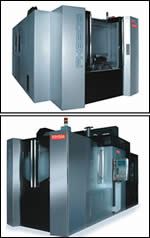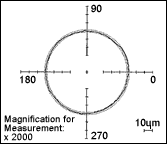Fast Machining With Fewer Tools
Machining centers capable of precise motion at high feed rates can reduce the number of tools it takes to complete a part.
Share


For production parts with various holes, the way to save time and cost with a high speed machining center would appear to be obvious. Simply put, the machine can move faster. Workpiece machinability may limit how quickly each feature of the part can be cut, but certainly the cycle time can still be reduced if the rapid traverse moves and tool changes are performed more quickly. A certain significant fraction of the processing time can be saved in this way.
But is this the best way for a high speed machine to improve productivity?
Not necessarily, say representatives of machine tool builder Toyoda. Machining centers that use linear motors for axis motion in place of rotary motors and ballscrews can improve the process by taking advantage of a different approach to machining holes. Because of their ability to maintain tight contouring accuracies at high feed rates, these machines can generate holes through circular milling to a level of speed and precision that may rival that of boring and other straight-line approaches. When one tool efficiently produces many different-sized holes in this way, the speed, capability and economy of the process can all improve.
Horizontal machining centers offered by Toyoda (U.S. headquarters in Arlington Heights, Illinois) include both fast machines with ballscrews and even faster machines that use linear motors. For these latter machines, the higher cost is an important drawback. Also important is the fact that quality ballscrew machines have done quite well, performing effectively even in applications where high feed rates are involved. But milling in circles is one application that does play to a linear motor strength—specifically, its capacity to achieve speed and precision at the same time.
When a machining center uses ballscrews, the rotary motor, ballscrew and drive train make up a mechanical linkage with various small opportunities for backlash and compliance. The overall result of this “play” is a measurable motion error whenever an axis reverses direction. The axis reversal error presents a problem in circular milling, because both the X and Y axes have to reverse direction in the course of feeding the machine through a circle. A higher feed rate only increases the magnitude of this error. As a result, a hole milled rapidly on a ballscrew machine is prone to fail a tight specification for hole roundness. The more standard approaches to hole making are therefore preferred.
A linear motor machine does away with much of the axis reversal error because it does away with the mechanical assembly. The linear motor moves along the axis, carrying with it the moving element of the machine. Because of this, the linear motor machine can mill out a high-precision hole at high feed rates. It can mill a precise hole so quickly, in fact, that it allows milling to rival more conventional hole-making approaches.
When the process relies on milling for hole making in this way, a variety of savings may result. Frank Petravicius, an account manager based in Toyoda’s Wixom, Michigan, office, summarizes the potential savings as follows:
- Tool management. Standard approaches to machining holes require a different tool for every different diameter. Precision circular milling can replace this variety with a single end mill. That means there are fewer tools to purchase, fewer tools to inventory and fewer tools to set up.
- Cycle time. Even on a fast machine tool, every tool change charges a price in cycle time. Each tool change requires the tool to leave the cut and come to a stop just long enough for tools to be swapped. But if one tool can machine a larger number of features, then some of that lost time is recaptured. The end mill can go directly from machining a large hole to machining a small one without a rest in between.
- Accuracy. “Every tool change represents one more chance for error, one more variable and one more uncertainty added to the process,” says Mr. Petravicius. Two different tools in two different toolholders might sit differently when they are loaded into the spindle. That difference may be important when it comes to machining the most precise features. But if one tool remains in the spindle to machine a variety of features, then that source of variation goes away, and feature-to-feature accuracy stands to improve.
Related Content
Where Micro-Laser Machining Is the Focus
A company that was once a consulting firm has become a successful micro-laser machine shop producing complex parts and features that most traditional CNC shops cannot machine.
Read MoreAddressing Manufacturing Challenges with Automation
GrayMatter Robotics’ Physical AI robotic cells for manufacturing offer immediate impact and results.
Read More4 Commonly Misapplied CNC Features
Misapplication of these important CNC features will result in wasted time, wasted or duplicated effort and/or wasted material.
Read MoreBallbar Testing Benefits Low-Volume Manufacturing
Thanks to ballbar testing with a Renishaw QC20-W, the Autodesk Technology Centers now have more confidence in their machine tools.
Read MoreRead Next
OEM Tour Video: Lean Manufacturing for Measurement and Metrology
How can a facility that requires manual work for some long-standing parts be made more efficient? Join us as we look inside The L. S. Starrett Company’s headquarters in Athol, Massachusetts, and see how this long-established OEM is updating its processes.
Read More
















-02.jpg;maxWidth=300;quality=90)





.png;maxWidth=300;quality=90)






